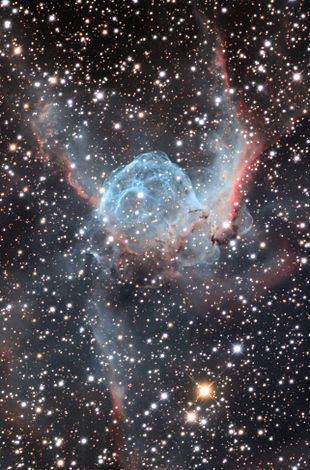NGC 2359
| Emission nebula | |
|---|---|
| NGC 2359 / Duck Nebula
|
|

|
|
| Image taken with the 81 cm reflecting telescope of the Mount Lemmon Observatory | |
| AladinLite | |
| Constellation | Big dog |
|
Position equinox : J2000.0 , epoch : J2000.0 |
|
| Right ascension | 07 h 18 m 31.0 s |
| declination | -13 ° 13 ′ 38 ″ |
| Appearance
|
|
| Apparent brightness (visual) | +11.45 mag |
| Angular expansion | 9 ′ × 6 ′ |
| Ionizing source | |
| designation | HD 56925 (WR 7, HIP 35378) |
| Type | WN |
| Physical data
|
|
| Affiliation | Milky Way |
| distance | approx. 15000 ly (approx. 5000 pc ) |
|
history
|
|
| discovery | Wilhelm Herschel |
| Date of discovery | January 31, 1785 |
| Catalog names | |
| NGC 2359 • LBN 1041, Sh2-298, Gum 4, RCW 5, GC 1511, h 3075, H V 21 | |
NGC 2359 , also known as the Duck Nebula and Thor's Helmet , is a Wolf-Rayet Ring Nebula (a special type of emission nebula ) in the constellation Great Dog . NGC 2359 has an apparent magnitude of +11.45 mag and an angular extent of 9 ′ × 6 ′. It is about 15,000 light years away from the solar system and has a diameter of about 20 light years . It expands at 26 kilometers per second. The mass of the bubble is estimated to be 70 to 140 solar masses .
In contrast to most of the others, this emission nebula is not excited to glow by O stars (such as the Orion Nebula ) or white dwarfs (such as the planetary nebulae ), but by a Wolf-Rayet star : HD 56925 (WR 7 , HIP 35378). This 11.4 mag bright star is located a little west of the center of the bubble and has an effective temperature of approx. 50,000 ° Celsius. The star builds up enormous radiation pressure , which blows the outer shells into interstellar space . The matter expelled and expelled over time forms a bubble which marks the front of the ejection.
Spectral analyzes suggest that the bubble-shaped nebula presumably consists of a mixture of material that the central Wolf-Rayet star lost in an earlier ejection and of the surrounding interstellar medium , which swirls, condenses and through the interaction with its strong stellar wind is ionized.
The object was discovered on January 31, 1785 by William Herschel . The object was cataloged by Wilhelm Tempel in 1877 as NGC 2361 , which describes part of the nebula.
Web links
- Astronomy Picture of the Day: Thor's Helmet
- The nebula "Thor's helmet", taken on the occasion of the 50th anniversary of ESO
- astronews.com: Picture of the day May 3, 2010
- astronews.com: Picture of the day September 19, 2013
Individual evidence
- ↑ NASA / IPAC EXTRAGALACTIC DATABASE
- ↑ SEDS : NGC 2359
- ↑ Michael Fritz in: Stars and Space February 2015 p. 60f
- ^ Adrian Kaminski in: Stars and Space December 2014 p. 14
- ↑ Seligman